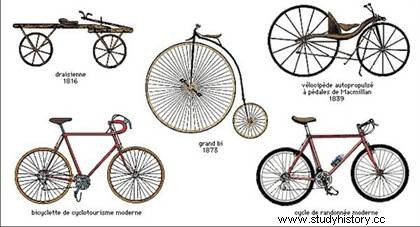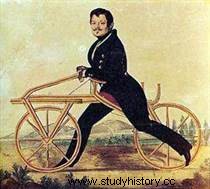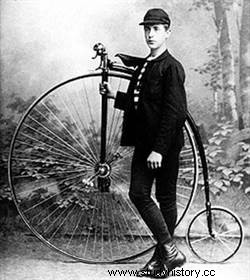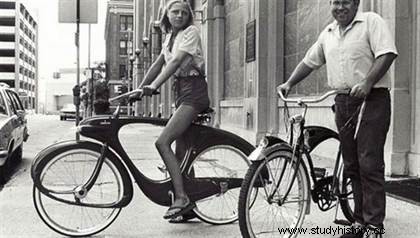 The Invention of the Bicycle (Bicycle) could go back to Leonardo da Vinci, author of a plan for a two-wheeled machine, ancestor of the bicycle, or to the mythical Count Mede de Sivrac supposed inventor of the celerifer in 1790. But it really began in 1817:the German baron Karl Drais von Sauerbronn present in the Jardin du Luxembourg, in Paris, a “seated running machine” made up of two iron wheels connected by a crosspiece and by the action of the feet on the ground. This first bicycle, followed by the pedal velocipede to the current electric bicycle, launched the adventure of two wheels.
The Invention of the Bicycle (Bicycle) could go back to Leonardo da Vinci, author of a plan for a two-wheeled machine, ancestor of the bicycle, or to the mythical Count Mede de Sivrac supposed inventor of the celerifer in 1790. But it really began in 1817:the German baron Karl Drais von Sauerbronn present in the Jardin du Luxembourg, in Paris, a “seated running machine” made up of two iron wheels connected by a crosspiece and by the action of the feet on the ground. This first bicycle, followed by the pedal velocipede to the current electric bicycle, launched the adventure of two wheels.
The first bike
As early as the second half of the 17th century, rudimentary two-wheeled vehicles, propelled by the feet, came into vogue. In 1690, a Frenchman invented the celerifer. It was a vehicle made up of a simple wooden beam on which the wheels were fixed, but without handlebars. The driver sat on a cushion placed on the beam while, to propel and guide the machine, he pushed on the ground with his feet. It was in 1816 that a German, engineer Karl Friedrich Drais, designed the first two-wheeled vehicle with a steering system. This machine, called draisienne (name derived from that of its inventor), had a handlebar that pivoted in the frame, thus allowing the front wheel to be turned.
 Afterwards, French, German and English inventors made all sorts of improvements. In Great Britain, one of the old models, the expensive curricle, was baptized dandy horse. Invented in 1818, the curricle was lighter than the balance bike and had an adjustable saddle and armrests. The first bicycle with pedals dates back to 1839, when drive levers and pedals were added to a balance bike type machine by Scotsman Kirkpatrick Macmillan. These innovations allowed the driver to propel the machine without his feet touching the ground. In 1846 an improved model of this machine, also designed by a Scotsman, was given the name dalzell and was widely used in Britain.
Afterwards, French, German and English inventors made all sorts of improvements. In Great Britain, one of the old models, the expensive curricle, was baptized dandy horse. Invented in 1818, the curricle was lighter than the balance bike and had an adjustable saddle and armrests. The first bicycle with pedals dates back to 1839, when drive levers and pedals were added to a balance bike type machine by Scotsman Kirkpatrick Macmillan. These innovations allowed the driver to propel the machine without his feet touching the ground. In 1846 an improved model of this machine, also designed by a Scotsman, was given the name dalzell and was widely used in Britain.
 Invention of the bicycle
Invention of the bicycle
But the direct precursor of the modern bicycle was the French velocipede, driven by cranks and free pedals. This became very fashionable in France around 1855. The frame and wheels were made of wood. The tread (the equivalent of our current tires) was iron, and the pedals were attached to the hub of the front wheel, the drive wheel, which was slightly higher than the rear wheel. The British called this object boneshaker (literally “!bone shaker!”), given its discomfort on a rough road or on a cobbled street.
The first machine to be patented as a bicycle dates back to 1869, when rubber tires mounted on steel rims were invented in Britain. Four years later, the British James Starley made a machine, the "big bi", which incorporated most of the equipment of a modern bicycle. The front wheel of Starley's machine was then three times larger than the rear wheel.
To the success of the bicycle
After the War of 1870, the development of velocipedes will continue especially in England. The front wheel gets bigger, and the back wheel gets smaller. This type of bicycle was then a resounding success. Subsequently, the locksmith craftsman Pierre Michaux and his son Ernest equip it with pedals, and 1885 for the latter are placed in their current position and connected to the rear wheel by a chain. The craze will no longer be denied, thanks to the popularity of country postmen and, from 1903, Tour de France riders.
Today, the bicycle remains the most widespread means of transport:there are 1.5 billion in the world. A time eclipsed by the car in industrial countries, it is making a comeback there. More or less depending on the country:the Dutch and the Danes cycle a thousand kilometers per year on average, the French one hundred. More recently, we have seen the general public's enthusiasm for a new type of bicycle, the all-terrain bicycle (MTB).
The future:the electric bicycle
 Electric bicycles, or rather electrically assisted bicycles, have enjoyed dazzling success in recent years and are reviving the use of bicycles , especially in urban areas. Its invention is not recent, it even dates from the end of the 19th century. It already has one or two electric motors installed in the wheels or in the pedals, and powered by a battery. The arrival of the motorcycle, powered by a gasoline engine, will for a long time overcome the electric bicycle. The latter will continue in the following decades to be improved, however without meeting commercial success.
Electric bicycles, or rather electrically assisted bicycles, have enjoyed dazzling success in recent years and are reviving the use of bicycles , especially in urban areas. Its invention is not recent, it even dates from the end of the 19th century. It already has one or two electric motors installed in the wheels or in the pedals, and powered by a battery. The arrival of the motorcycle, powered by a gasoline engine, will for a long time overcome the electric bicycle. The latter will continue in the following decades to be improved, however without meeting commercial success.
Contemporary environmental considerations and the emphasis on "soft" transportation are giving this mode of travel a second chance. Non-polluting and requiring little physical effort, the electrically assisted bicycle is now favored by city dwellers. Although its price remains high overall (between 500 and several thousand euros), its growing success should make it more accessible to as many people as possible in the years to come.
Bibliography
- Short stories of transport:Or how the means of transport have evolved since their invention by Pierre LEFEVRE. bayard, 2014.
- 50 bicycles that have marked the history of cycling. Editions of the unexpected, 2017.
To go further
- Tournus Bike Museum
